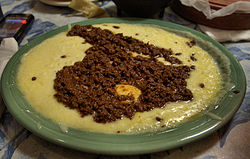 Queso flameado made with Oaxaca cheese and chorizo | |
| Course | Hors d'oeuvre |
|---|---|
| Place of origin | Mexico |
| Serving temperature | Flambé |
| Main ingredients | Cheese, spicy chorizo |
Queso flameado (lit. 'flamed cheese'), also known as queso fundido or choriqueso,[1] is a dish of hot melted cheese and spicy chorizo that is often served flambé. Often compared to cheese fondue, it is a party dish; it is popular at cookouts and in restaurants as an appetizer.[1] Almost unique in Mexican cuisine,[1] in the cuisine of the United States this dish has been widely adapted and is considered a native dish in El Paso.[2][3] In Mexico, it occurs in restaurants more often in the north.[1] Typical main ingredients are melted cheese and a characteristic meat sauce of loose fresh chorizo, tomato, onion, chile and spices. It is served in a small, shallow casserole or other ceramic or metal heat-proof baking dish. The cheese and sauce are prepared separately, and combined just before serving. This may be done at the table, especially if finished with a flambé: high alcohol liquor is poured on the cheese and ignited, and as it burns the server folds in the sauce. If not flambéed, the mixture may be quickly broiled. Either way, the finished dish is presented while it is still bubbling hot, and it is spooned onto small soft tortillas for individual servings.
Queso flameado is said to originate in the borderlands of northern Mexico and the southwestern United States, as a campfire dish.[4]
In Tex-Mex restaurants, this dish is sometimes confused or conflated with chili con queso, a cheese sauce served with tortilla chips for dipping.[2] The term queso fundido also refers to processed cheese[5] and is defined as such in the Spanish version of Codex Alimentarius.[6]
- ^ a b c d Cite error: The named reference
Baylesswas invoked but never defined (see the help page). - ^ a b David Rosengarten (2003). It's all American food: the best recipes for more than 400 new American classics. Little, Brown and Company. p. 487. ISBN 0-316-05315-5.[dead link]
- ^ Cite error: The named reference
WagnerMarquezwas invoked but never defined (see the help page). - ^ Bill Jamison (1995). The border cookbook: authentic home cooking of the American Southwest and Northern Mexico. Harvard Common Press. pp. 500. ISBN 1-55832-103-9.
- ^ Lambert, J.C. (1990). La elaboración de la leche en las aldeas. Estudio FAO. Producción y sanidad animal (in Spanish). Food and Agriculture Organization. p. 71. ISBN 92-5-302679-0.
- ^ FAO (2001). Leche y productos lácteos. Codex Alimentarius (in Spanish). Vol. 12 (2 ed.). Food and Agriculture Organization. p. 130. ISBN 92-5-304497-7.